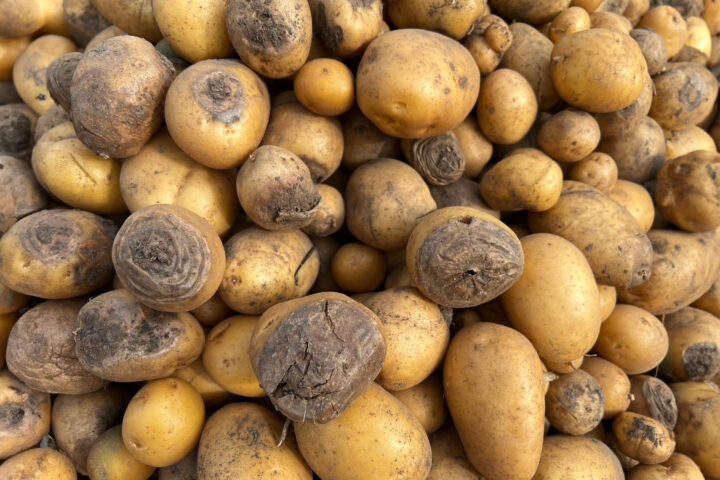
“Different Rules for Genome Editing Are Welcome”
The Swiss Federal Council and the National Council of Switzerland want to put new cultivation methods under the existing GMO moratorium. A majority of the SECC-S decided on Tuesday that the cultivation of genome-edited plants is to be permitted subject to requirements. We discussed this decision with Jan Lucht, an expert on biotechnology from scienceindustries.
Thursday, November 18, 2021

Mr. Lucht, how might such a rule look as defined by the SECC-S?
The Science, Education and Culture Committee of the Council of States wants organisms that have been modified with the help of genome editing and do not contain any foreign genetic material to be exempt from the moratorium. The fact that the SECC-S is looking to introduce different rules for products created using new cultivation methods is an important political signal and is extremely welcome. It shows that not every method of genetic engineering should be tarred with the same brush, but instead judged according to their individual applications. However, it must not be forgotten that an exception to the moratorium alone cannot resolve the legal uncertainty that exists in the application of new genetic engineering methods. The legislator must clarify which rules are to apply in future for genome-edited products so that these can actually be applied – also for applications outside of plant cultivation, such as with micro-organisms and animals. These rules should be prepared together with the affected groups. Widespread public discussion is also important to develop viable solutions for the future.
Are there any examples from outside of Switzerland that could be used as a guide? When discussing new methods, Canada has also been mentioned on numerous occasions. How is the approval process regulated there?
As it happens, a number of key agricultural countries have already developed regulations for handling genome-edited products. These do, however, differ from one country to the next. In the US, genome-edited crops that do not contain any foreign genetic information are not subject to any special regulation. They can be cultivated without having to meet any requirements, as they can also be grown using conventional cultivation methods.
In several Latin American countries, e.g. Argentina, similar regulations have been put in place – but there are no blanket exemptions with respect to approval obligations. The developers of new plant varieties that use methods such as genome editing must disclose their information to the regulatory authorities. The authorities subsequently make a case-by-case decision on how the new variety is to be classified. In such instances, products created using new cultivation methods and that do not contain any foreign genetic information are not normally considered to be “genetically modified” and can be cultivated without any commensurate requirements.
Canada is a very special case in that here every newly developed plant with significantly modified properties is subject to thorough testing prior to being approved for cultivation – regardless of whether it has been created using conventional cultivation methods, by means of traditional genetic modifications with a gene-modified plant of a different variety, or through genome editing. On one hand, this is scientifically consistent – it is the verifiable properties of a plant that determine the potential risk of a new plant variety, and not the production methods. On the other hand, this approach results in more time, effort and money being needed for conventional plant cultivation. Before such a model is adopted without any changes needing to be made, a careful balance would have to be struck between the potential increase in safety and the additional work and expenses required for a much more comprehensive testing of new varieties. In principle, different combinations of established methods from other countries can also be implemented, whereby the different types of testing required should be based on the potential risks. This lends itself to a greater focus on the actual properties of a plant and less on the technical manufacturing processes that are constantly changing due to the rapid development of methods.
If the majority of the SECC-S get their way, a distinction should in future be made between cultivation methods that make modifications within the same plant variety and cultivation methods that introduce genetic material that is foreign to the variety. Does such a legal distinction make sense from a research perspective?
For more than 25 years, genetically modified crops have been grown on just over 13% of the world’s arable land without evidence having been found of any specific risks, e.g. for human health. No specific risks are likewise to be expected from plants developed with new methods, which only contain species-specific genetic information or could be cultivated by means of conventional methods – in theory, there would perhaps be even fewer unexpected effects here. It is debatable whether the distinction between “safe” and “perhaps somewhat safer” justifies different legal treatment from a scientific point of view. Nevertheless, legal regulations are based not only on scientific principles, but also on social perception – and this is where there is a distinction between genetically modified plants and products created using innovative cultivation methods, such as genome editing and cisgenesis with species-specific genetic information, e.g. from wild varieties that could also be grown through conventional cultivation or in the wild.
Critics of the new cultivation methods complain that many aspects are still up in the air and they say that there are no concrete examples that have shown that there is actually demand for genome-edited crops. Is this criticism correct? Is there a lack of actual beneficial uses?
The new methods of plant cultivation, such as the use of CRISPR/Cas9, have triggered a real boost in innovation. More than 400 genome-edited plants with a wide range of improved properties are in development, a large number are already at advanced stage, and the first few have already been launched on the market. Calyno soybean oil, which is comparatively healthier than other oils, is being sold in the US as a premium product and is in demand among consumers. More and more products are quickly being launched on the market around the world –- but the question is how long this will take in Europe and Switzerland due to the high legal hurdles that currently have to be overcome.
Should genome-edited plants be approved in Switzerland in the days to come, where do you see potential uses for them in this country?
Genome editing is expanding the global range of varieties with new, previously unavailable or rare properties. The specific varieties that will be used in an individual country depend on the local agricultural requirements as well as those of its society. In Switzerland, a great deal of importance is attached to agriculture that is as sustainable and resource-efficient as possible. Therefore, I believe that disease-resistant varieties that reduce the need for plant protection products are a particularly important field of application. As local production is valued particularly highly here in Switzerland, the modification of established and popular varieties to meet changing cultivation conditions, such as climate change, could also become important to ensure that these varieties can continue to be grown in Switzerland. Nevertheless, healthier products such as those with an improved fatty acid composition could also pique consumer interest.
In which areas is genome editing research currently focused? Are scientists looking into optimizing yields, or perhaps they are focusing on pest protection or tolerances? In which area is the most intensive work currently being carried out with the new cultivation methods?
In spring 2021, the EU presented a comprehensive study that provided an overview of the global development pipeline for genome-edited organisms. This included descriptions of 426 applications for plants that were being prepared for market launch. The most important areas of genome editing in plant cultivation are currently the optimization of plant compositions (nutrients, starch, oil, vitamins, allergens, etc.) with 115 projects as well as the increase of resistance to diseases (to fungi, viruses, bacteria, parasites, etc.) with 113 projects. Some 88 projects are attempting to increase yields and develop more suitable growth forms, while an improved resistance to environmental factors such as heat, drought, salt and flooding is the focus of 38 research strategies. Further cultivation objectives, each making up less than 10% of the total number of applications, include technical improvements for variety development, herbicide tolerance, improved storage properties as well as changes in color and odor.
Related articles

Assess scientifically instead of banning indiscriminately
The debate surrounding PFAS is gaining momentum in Switzerland. At its core are questions about potential risks to human health and the environment, as well as future regulatory approaches. A differentiated, science-based approach is essential – as emphasised by scienceindustries in a short interview with Dominique Werner, Head of Chemicals Regulation.

Faster Approval of Crop Protection Products Long Overdue
Switzerland diligently bans active substances that have also been withdrawn from the market in the EU. Conversely, it is dragging its feet: modern products that are approved in neighboring countries remain blocked. With the adoption of the amendment to the Agriculture Act, the National Council has now taken an important step toward faster approval of plant protection products.

Differing perceptions
While the increasing administrative burden is perceived as the main concern in the economy, parts of the population see it differently. Meanwhile, regulations are repeatedly misused as a means of exerting power in the competitive struggle – to the detriment of SMEs.

Domestic production as a blind spot
Switzerland's food security is increasingly under pressure: last year's disastrous wheat and potato harvests have led to an increasing dependence on imports. However, the report by the Federal Office for National Economic Supply (FONES) is largely silent on the precarious state of the domestic agricultural sector. The IG BauernUnternehmen (Farmers' Company) has therefore sharply criticised the federal government.

